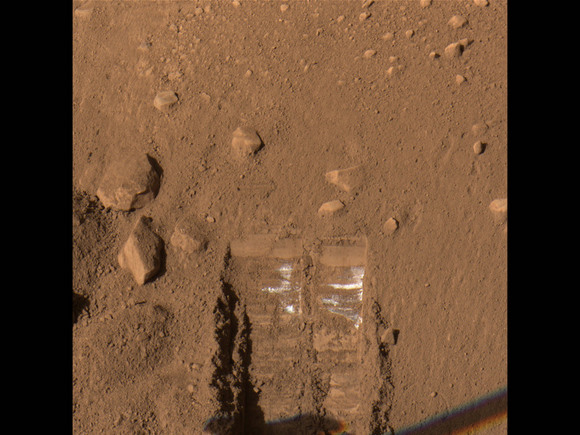The Phoenix lander team revealed the latest images from the mission at a press briefing on Friday. This first image shows an area dug by Phoenix's scoop, which disclosed a bright surface just a few inches down, which may be ice. "There's still some debate about the bright material," said Phoenix Principle Investigator Peter Smith. "Not everyone is sure that this is ice. So there's been some debate on our team, centering around that perhaps there's a salt layer just under the soil that also would be bright. Everyone does believe there's ice under the surface, and whether this is ice or not is the question. The other question is, is this thick ice that goes down deep beneath the surface, or is this a thin layer and we'll be able to scrape through? So being able to scrape with our scoop is a high priority for us."
This pair of images taken by the Optical Microscope on NASA's Phoenix Mars Lander offers a side-by-side comparison of an airfall dust sample collected on a substrate exposed during landing (left) and a soil sample scooped up from the surface of the ground beside the lander. In both cases the sample is collected on a silicone substrate, which provides a sticky surface holding sample particles for observation by the microscope.
Similar fine particles at the resolution limit of the microscope are seen in both samples, indicating that the soil has formed from settling of dust.
The microscope took the image on the left during Phoenix's Sol 9 (June 3, 2008), or the ninth Martian day after landing. It took the image on the right during Sol 17 (June 11, 2008).
The scale bar is 1 millimeter (0.04 inch).
This is the latest color image of Phoenix, its surroundings and the scoop with soil.
While we can't look inside the Thermal and Evolved Gas Analyzer (TEGA) oven which will "bake" the Martian soil to test the type of gases that are released, we can see that some of the soil has gone into TEGA. "We were finally successful and some of the material has slid down over the screen" said Smith, "sort of like material going over a cheese grater, and some of the material has slid down and filled the oven. We sent the commands for the first operation of TEGA last night, but we don't have our data back yet, so we can't report on any results. That will be coming later next week. So this is a very exciting time for us. We find the soil is very clumpy, it's sticky, it's an unusual soil not at all like the types of soils we used in our tests, which worked just fine with all the instruments. So we've developed another method of collecting samples, which is to tilt the scoop and vibrate it, and so it shakes down a small amount of material onto the instruments."
And finally, here's the latest weather report for Mars, on the 17th sol of Phoenix's stay on Mars.
Sources:
Phoenix News
, NASA TV
 Universe Today
Universe Today
